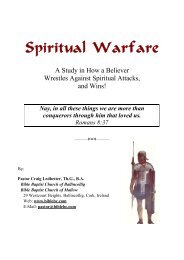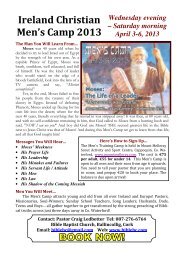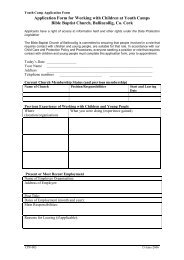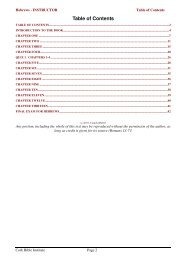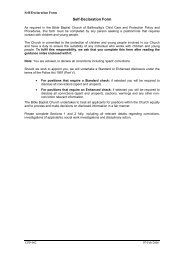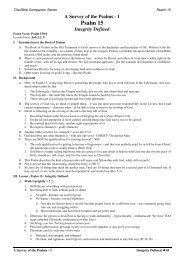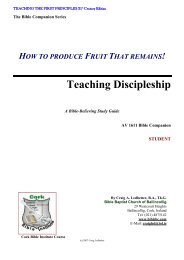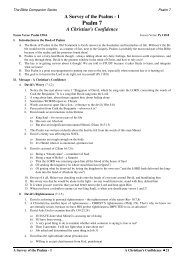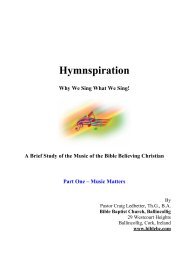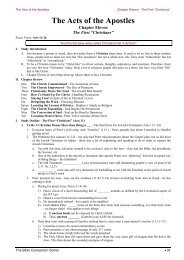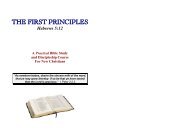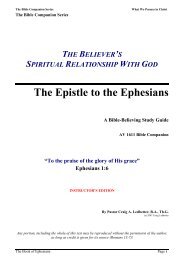Old Testament Survey - Student.pdf - Bible Baptist Church of Blarney
Old Testament Survey - Student.pdf - Bible Baptist Church of Blarney
Old Testament Survey - Student.pdf - Bible Baptist Church of Blarney
You also want an ePaper? Increase the reach of your titles
YUMPU automatically turns print PDFs into web optimized ePapers that Google loves.
<strong>Old</strong> <strong>Testament</strong> <strong>Survey</strong><br />
Preliminary <strong>Bible</strong> Information<br />
d. Lectionaries - These are collections <strong>of</strong> the gospels and epistles for reading in<br />
churches, some dating back from, the 7th to the 10th centuries. They help in<br />
determining the exact text. Of these there are more than 1, 000 <strong>of</strong> the gospels and 300<br />
<strong>of</strong> the Acts and epistles<br />
e. Patristic quotations - These are quotations <strong>of</strong> the <strong>Bible</strong> by early Christian writersthose<br />
<strong>of</strong> the first 3 centuries. They help in determining the exact text, filling the gap<br />
between the time <strong>of</strong> the apostles and the earliest MSS. <strong>of</strong> the 4th century. If the N.T.<br />
were destroyed it could be practically reproduced from these quotations <strong>of</strong> the early<br />
fathers alone. See The Ante-Nicene Fathers<br />
f. Ancient versions - The many ancient versions <strong>of</strong> Scripture in many languages, dating<br />
from the 2 nd century to the 12th century A. D. add much to the pro<strong>of</strong> <strong>of</strong> the<br />
genuineness and authenticity <strong>of</strong> the <strong>Bible</strong>.<br />
1) Septuagint in Greek, 2 nd or 3 rd century A.D.<br />
2) Persian version, 2nd century A .D.<br />
3) Samaritan Pentateuch, 1st or 2 nd century A. D.<br />
4) Version <strong>of</strong> Aquila. Greek <strong>of</strong> the O.T. about 160 A. D.<br />
5) Version <strong>of</strong> Theodotian, O.T. in Greek, 2nd century A. D.<br />
6) Version <strong>of</strong> Symachus, O.T. in Greek, 2nd century A. D.<br />
7) Peshitta Syriac version, 2nd century A. D. ..<br />
8) Armenian version, 5th century A. D.<br />
9) Egyptian version, 4th century A. D.<br />
10) Ethiopic v e r s ion, 4th century A.D.<br />
11) Gothic version, 4th century A. D.<br />
12) Latin version, 4th century A. D.<br />
13) Georgian version, 6th century A. D.<br />
14) Chaldee targum paraphrases <strong>of</strong> portions <strong>of</strong> the <strong>Old</strong> <strong>Testament</strong>, 8th-11th centuries<br />
A.D.<br />
15) Arabic version, 8-12th century A. D.<br />
4. The <strong>Bible</strong> text as we now have it is the same as that passed down through all these<br />
sources from the earliest times, so there should be no question in the mind <strong>of</strong> anyone<br />
regarding the genu1neness and authenticity <strong>of</strong> the Scriptures<br />
G. How we got our English <strong>Bible</strong><br />
1. Our English <strong>Bible</strong> is the result <strong>of</strong> 1200 years <strong>of</strong> work by all kinds <strong>of</strong> learned men.<br />
Portions were trans. from the Vulgate, the Latin version. beginning as far back as<br />
700A.D., when Aldhelm trans. the Psalms into Saxon. Egbert translated the 4 gospels<br />
sometime later. In 735A.D. Bede trans. parts <strong>of</strong> the Scriptures into Saxon. King Alfred<br />
undertook a translation <strong>of</strong> the Psalms but died in 900 A. D. before it was finished. Elfric<br />
trans. the Pentateuch and some <strong>of</strong> the historical books in the 10th century .<br />
2. Nothing else was done about translation from then to the time <strong>of</strong> John Wyclif, who made<br />
the first complete English <strong>Bible</strong> from the Vulgate in 1380 A. D.<br />
3. The next was a N.T. by William Tyndale in 1535and the Pentateuch in 1530.<br />
4. In 1535 Miles Coverdale made the first complete printed English <strong>Bible</strong>.<br />
5. Then came the Geneva <strong>Bible</strong> in 1560 A. D.,<br />
6. Followed by Bishop's <strong>Bible</strong> in 1563 and revised in 1568.<br />
7. The Roman church came out with the Douay version <strong>of</strong> the N.T. in 1582 and the whole<br />
<strong>Bible</strong> in 1609 which has been used by that church up until now.<br />
8. In 1604 King James authorized 47 men to make a complete translation <strong>of</strong> the <strong>Bible</strong> from<br />
the original languages. It was finished in 1611 after 7-8 years <strong>of</strong> diligent work. It has been<br />
the most popular and accepted version <strong>of</strong> the English speaking world from that day until<br />
now. There have been several revised versions since then, and a number <strong>of</strong> <strong>Bible</strong>s in the<br />
so-called modern English, but none have been as well accepted and as lasting as the King<br />
James version - and perhaps never will be.<br />
CBI - Practical Doctrine Page 10



